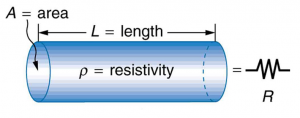Resistivity
In this lab you will study resistance and Ohm’s Law by finding the resistivity of a wire made of play-Doh.
Objectives
- Make a “resistor” using a long, thin “wire” made of modeling compound (e.g. play-Doh)
- Determine the resistivity of your material.
Resources
- modeling compound (e.g. Play-Doh)
- Power Supply
- Wires, alligator clips, metal strips
- Note: avoid inserting wires or alligator clips into modeling compound, as they will corrode quickly. Use the metal strips for contact points when possible.
- Multimeter
Background
A resistor is a device that impedes current flow. The resistance is defined as the voltage drop across the device divided by the current through the device. R=\frac{V}{I}
 Physically, the value of a resistor will depend on its shape and what it is made of. Different materials impede the flow of charge (current) to different degrees. The ratio between the electric field strength in a material and the current produced by it is the resistivity, and has units of Ohm-meters. A resistor of length L and cross-sectional area A, made of a material with resistivity \rho has a resistance R=\rho\frac{L}{A}
Physically, the value of a resistor will depend on its shape and what it is made of. Different materials impede the flow of charge (current) to different degrees. The ratio between the electric field strength in a material and the current produced by it is the resistivity, and has units of Ohm-meters. A resistor of length L and cross-sectional area A, made of a material with resistivity \rho has a resistance R=\rho\frac{L}{A}
Ohm’s Law is the claim that for a given resistor, the current will always increase proportionally with the voltage applied to it. In effect, this says that V=IR, with R being constant for all voltages. For real materials, there is always deviation from Ohm’s Law for sufficiently large voltages and hence electric field magnitudes.
Guidelines/Hints
- Make sure you understand how to measure current with a multimeter. Tutorials/videos on the web such as this one may help.
- Using the resistance setting on a multimeter to directly measure the resistance of a material like play-Doh gives poor results because the probes do not make good contact, and the meter does not generate enough current to get a good reading. For this reason, it may work better to use the four-wire method (i.e. apply a voltage to the play-Doh and measure the voltage and current through it) to measure the resistance.
- Using a very thick (i.e. large cross-sectional area A wire may give poor results because of the very low resistance and thus high current, which will heat up the play-Doh and change its properties.
- You will have to test a large range of voltages to achieve your second objective. Depending on the overall resistance of the play-Doh “wire(s)” you construct, you may or may not be able to produce high enough voltages to see any deviation from Ohmic behavior in the play-Doh.